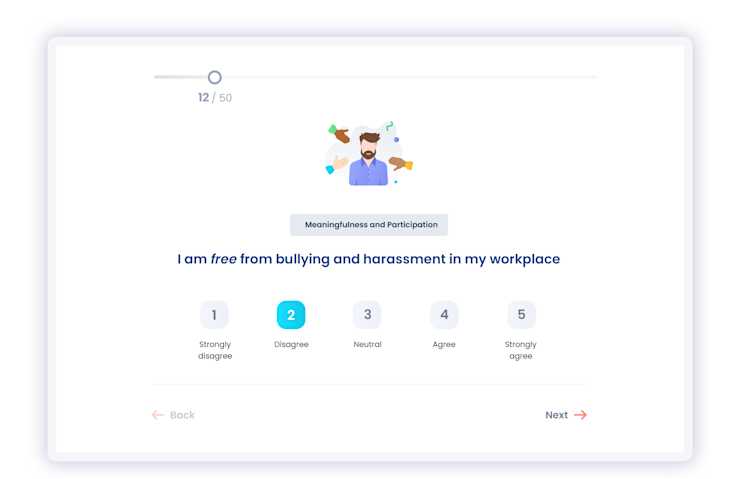Employee engagement surveys are powerful tools for gauging the overall health of a workplace environment. Among the various aspects measured, the assessment of bullying and harassment is a critical component.
In the world of employee engagement surveys, you'll encounter a diverse array of tools and methodologies for measuring the employee experience. These approaches range from free-text responses to four-answer scales, and some allow respondents to express their feelings through interactive sliders, icons, or symbols.
At Eletive, we use a five-point scale, also known as the Likert Scale. We use this tried and tested approach because it's the methodology that brings the best scientific validity.
But aren't some questions binary, you may wonder? The topic of bullying and harassment is an area where your initial thought might be that "either you experience harassment, or you don't, so why a scale of 1-5?"
In this article, we will discuss why a 5-point Likert Scale is a valuable instrument for assessing bullying and harassment, emphasizing the nuances and degrees of dysfunction that it can capture.
Recommended reading: Employee engagement surveys - the case for a 5-point Likert Scale

By allowing a nuanced way to respond, organisations can detect issues earlier and track if things are moving in the right or wrong direction.
Recognising the complexity of bullying and harassment in the workplace
Workplace bullying and harassment are multifaceted issues that can manifest in various forms and intensities. It is essential to acknowledge that these behaviours exist on a continuum, rather than as binary occurrences. By adopting a broader perspective, we can better understand the complexities and nuances that individuals may experience in their workplace environments.
Capturing degrees of dysfunction
The 5-point Likert Scale provides a structured way to capture the varying degrees of bullying and harassment experienced by employees. Unlike a simple "yes or no" question, it allows respondents to express the extent to which they perceive such behaviours in their workplace. This gradation is invaluable in identifying subtle and ongoing issues that might otherwise go unnoticed.
Encouraging honest feedback
In surveys regarding sensitive topics like bullying and harassment, respondents may hesitate to report their experiences if they are only given a binary choice. They may fear potential repercussions or may not fully grasp the severity of the issue. A 5-point Likert Scale, on the other hand, offers respondents the freedom to express their feelings and experiences more accurately, creating a safe space for honest feedback.
Identifying trends and patterns
With a 5-point Likert Scale, organisations can identify trends and patterns in the data. This level of granularity enables HR and management to discern whether certain departments, teams, or individuals are more prone to experiencing or perpetuating bullying and harassment. Such insights can be invaluable in developing targeted interventions and prevention strategies.
Establishing benchmarks and tracking progress
By using a Likert Scale over time, organisations can establish benchmarks for the prevalence and severity of bullying and harassment in their workplaces. This allows for the tracking of progress in addressing these issues. Gradual improvements in survey scores can indicate that the organisation's efforts to create a healthier work environment are effective.
In summary
In the assessment of workplace bullying and harassment, the 5-point Likert Scale proves to be a valuable tool for capturing the nuanced and varied experiences of employees. By recognising that these issues exist on a spectrum, organisations can gain deeper insights into the dynamics of their workplace culture.
This, in turn, enables you to implement targeted strategies for prevention and intervention, fostering a safer and more inclusive environment for all employees. Embracing the complexity of these issues through the Likert Scale ultimately contributes to the overall well-being and engagement of the workforce.

























